To Those Who Marched at Sainte-Soline
Les Soulèvements de la Terre
The following reflections were sent to us by members of Les Soulèvements de la Terre, a French collective that has organized multiple seasons of mass collective sabotage against water-grabbing agroindustry. The events at Sainte-Soline on March 24-25th 2023, including the unprecedented police assault on environmental protestors that seriously wounded hundreds and left two lives hanging in the balance, have become a national flashpoint in France, provoking serious criticism of the police. At the same time, they have prompted difficult reflections among comrades about the new regimes of authoritarian repression confronting ecological movements, from Atlanta to France. Whereas our previous translation, “The Trap of Sainte-Soline,” surveyed the strategies of police in order to analyze this new paradigm of counter-insurgent repression, the present text attempts to draw lessons from the movement’s own strategic failures. Beyond the details of the French situation, the authors pose a series of questions that apply to all successful compositional struggles: how do we recognize when the rapid growth of a struggle has eclipsed the initial strategic framework, and change up? How do movements that decenter the function of a leading group or vanguard replace the necessary functions of communication, information-sharing, strategic planning, and decision-making on the fly? How do we recognize when the framework of conflict in which we are fighting has become lodged in a closed dialectic, or when its mode of confrontation has allowed itself to be bogged down in a war of attrition, closing off avenues of escape? Such questions are by no means limited to Europe, many of them having been already encountered during the mobilizations at Standing Rock, in the anti-fascist struggle during the Trump era, or during the 2020 rebellion against police power in the USA.
Other languages: Français
Three weeks have passed since March 25 at Sainte-Soline, a day that will remain forever ingrained in our bodies and memories. Since then, it feels as if we’ve been trapped within a game of ping pong between the government’s aggressive offensive and our counter-offensives, which sought to establish a semblance of truth about what took place and the current political context. This has pushed us, amongst many other undertakings, to accept conditions of speech that were far from satisfactory and which limited our possibilities of expression, including TV appearances. For the injured and for the future, we cannot give free reign to so much indecency and lies spread by authorities that are literally running wild. It’s time that we step out of the emergency response mode and address a series of legitimate questions. We are only just now beginning to process this weekend (which took months to prepare) in a critical and collective way; nevertheless, it’s important that we share some explanations and interpretations on our part.
We would like to share them with everyone who walked the 12 kilometers with us that day, those with whom we attempted, as best we could, to encircle the construction site of the Sainte-Soline mega-reservoir [méga-bassine]: those who came on a whim, as well as those who had been preparing for this day for some time; those who arrived by bicycle convoy from Brittany, as well as those who took a break between blockades and demos to join us in Deux-Sèvres; all the people who traveled from Italy, Germany, Switzerland, and Belgium; those who managed to slip past the police roadblocks and helped set up the camp, or simply made it there by Friday. But also those who endured repeated police controls in Melle during the days prior and opted as a result to hang back at the festival grounds and keep an eye on things. Finally, those who were unable to make it at all, but who joined us in their hearts.
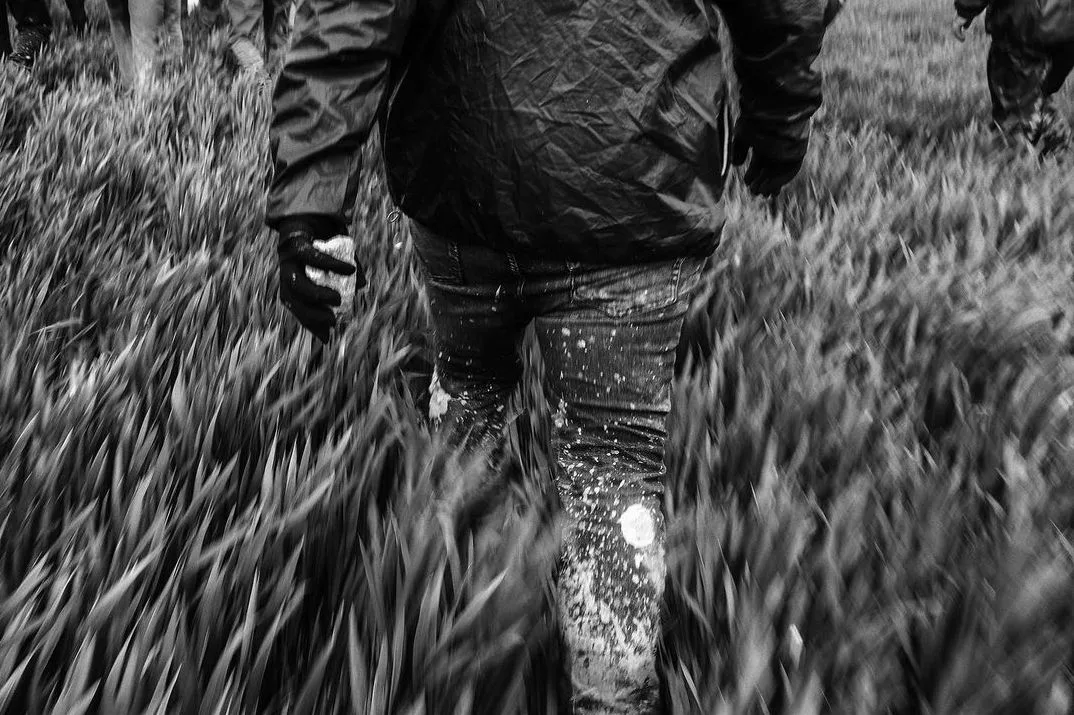
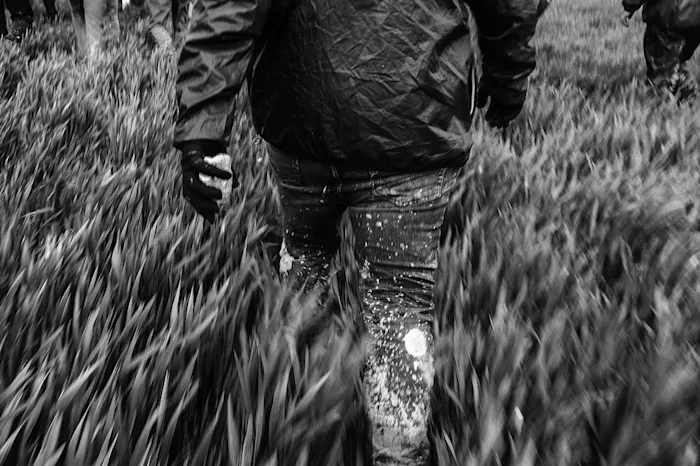
What matters to us is that we find ways to continue fighting together; this is why we share these reflections, imperfect and fragmented as they may be. We don’t yet possess the necessary distance to draw very many decisive conclusions concerning the specific events of March 25, or even about the longer timeframe of struggle against the mega-reservoirs in Deux-Sèvres. This will take time, and will be undertaken in several steps. But to begin, it seems important to remember how we got here. What was the context, and the state of power relations that led to the events of March 25?
1. Some contextual elements
Stop the mega-reservoirs
Over the past two years, the struggle against the mega-reservoirs saw an unprecedented acceleration both at the level of sheer participation as well as in the tactics deployed.
In September 2021, the construction of the mega-reservoir at Mauzé sur Mignon was joyously invaded by 500 demonstrators and a convoy of tractors: as demonstrators resisted the police, an excavator was disabled.
On November 6 2021, 3000 people cleverly opted to bypass the construction site at Mauzé sur Mignon, where 1000 police — as well as farmers from the FNSEA1 and the Coordination Rurale2 — were waiting for them, and instead dismantled the neighboring reservoir at Cram-Chaban, which had its pump dismantled with the help of the Confédération Paysanne. The force of this gesture, which was the result of a coordination between Bassines Non Merci, Confédération Paysanne, and Soulèvements de la Terre, lay in its effort to push beyond the traditional form of the political demonstration, insisting on the political urgency of collectively disarming infrastructure and disrupting construction sites.
At Rochénard the following March, the crowd of 6000 people decided not to venture into the red zone and instead to dismantle the pipes at a nearby reservoir still under construction.
At the first excursion at the Sainte-Soline site on October 29-30 2022, 8000 demonstrators split up into three marches with the aim of confronting the police lines according to distinct tactical approaches. After significant clashes, the first column managed to force its way into the reservoir, before the other two danced their way in. Still, the column that briefly occupied the construction site endured heavy grenade fire from police, with the demonstration ending in a pattern of clashes that foreshadowed the limits we would encounter on March 25, as a single fixed point faced off with the whole police line guarding the reservoir.
In the aftermath of this action, construction at the Sainte-Soline location was paused for two weeks, partly due to the damage inflicted upon the fences that enclose it, but above all because the visibility and the power balance around these projects had now crossed a threshold.
If we can’t always stop construction completely, we can participate in creating an unmanageable and costly situation for our opponents. Of the seventeen reservoirs planned in the Deux-Sèvres region, only two have broken ground. No other work has yet started, although several are planned. This is a direct consequence both of daytime demonstrations carried out by the organization as well as the anonymous work of nighttime artisans who disarmed thirteen reservoirs in the area, along with the colossal work of scientific counter-investigations designed to undermine the arguments of agribusiness.
General Strategy
The aim of the struggle against the mega-reservoirs led by the Confédération paysanne, Bassines Non Merci, and Les Soulèvements de la Terre is to halt project construction while creating the conditions for a genuine debate over the usage and distribution of water understood as a common good. However, this takes time. The first battle of Sainte-Soline did not bring about the definitive end of construction, and we knew that, by itself, a new mobilization wouldn’t either.
In line with the chant, “Not one more reservoir,” the agreements and shared feelings that we have progressively built between different collectives and organizations engaged in the struggle led us to target the construction of new reservoirs rather than older ones. Without any new construction site available to focus on after October’s demonstration, and with the Sainte-Soline reservoir still under construction, it quickly became the agreed upon target. Well aware of the difficulty of trying to reproduce for a second time the same action on the same terrain, we carefully studied other ideas for weeks, but none ultimately corresponded to the common criteria for a new mobilization.


Four objectives were established during the March meeting:
to gather at least twice as many participants as in October.
to confer a greater visibility of farmers’ participation in the struggle.
to ensure that the demonstration impacts the construction site again. No one in the coordination imagined a simple stroll through the countryside or a demonstration without a strategic objective.
to create the material conditions for useful debates over water, while highlighting the international dimension of the struggle.
The Mellois region is not a desert
The strength of the Bassines Non Merci collective lay in its tenacious ability to carry out a local fight against the construction of reservoirs over the span of several years, thereby initiating a broader reflection over the sharing of water. For many participants, the organization of two days of discussions, conferences, and concerts during the next mobilization was every bit as important as the demonstration itself. Given the material precarity that the harsh terrain carried with it, it felt necessary to ensure that a permanent base camp existed. To this end, the town of Melle courageously agreed to play host to the events that took place alongside the demonstration, giving the town a way to pledge its support for resistance to the mega-reservoirs.
Over the course of two years — and this is one of the strengths of this struggle — each event we organized together considerably extended the field of struggle and allowed us to forge new alliances. One by one, most of the local actors have chosen sides and participated in problematizing the project and its long term consequences. Making time for a festival and a conference in Melle was thus also a way to confer visibility upon the locals who inhabit this region and contribute to making the large mobilizations possible — a way to show that the Mellois region is not a desert but a territory populated with people who struggle and take the place where they live seriously.
As the local political context is concerned, it’s been remarkable to see how many such folks are prepared to welcome the struggle, offering up their work tools (tractors for farmers, flatbed trucks for craftsmen, forklifts, etc.) as well as their time and their networks. Yet even though a large part of the population supports the struggle against the reservoirs, the local political context is strained, and the FNSEA still controls a portion of the political life of Deux-Sèvres. As such, it’s not easy to find space for thousands of people to camp and park their cars without exposing oneself to a certain climate of hostility.
What’s lacking ground, the water or the ecologists?
One of the strategies used by the government and the pro-reservoir groups has been to pit farmers against environmentalists. The struggle against the mega-reservoirs is supposedly led only by outside environmentalists who understand nothing about the stakes and difficulties of the agricultural world. However, farmers have struggled against water grabbing for years. The internal conflicts of the agricultural world are powerful, but often smoothed over and ignored.
During the Spring Vegetable Market demonstration in March 2022, the farmers’ tractors that faced off against the mega-reservoirs were rendered invisible, in part because they were unable to join the march of demonstrators due to a police barricade. After the media explosion on this topic, with its focus on violence, it felt essential to insist once again on the strong participation of farmers in this struggle. A convoy of fifty tractors from all over France was thus ready to come to the mobilization, with the goal of joining Friday’s camp. The presence of the tractors was all the more important, as the FNSEA had just demonstrated in favor of the reservoirs and pesticides a few days prior at Rochelle on March 22.
These contextual elements explain why we didn’t organize only one demonstration, but instead three separate but complementary events:
Discussions, conferences, and round tables with people from abroad, accompanied by concerts, canteens and bars for 10000 people.
A convoy of tractors, joined by various car convoys, between Friday and Saturday morning.
A demonstration of more than 20000 people that needed to take place in a different region than Melle, in a town that didn’t have the infrastructure to welcome as many people.
2. Tactics on familiar ground
The dramatic outcome of Saturday’s demonstration and the subsequent ridiculous statements by state figures like Darmanin tended to overshadow what made the weekend so diverse. Whereas discussion has largely centered on what transpired that Saturday, it’s important to remember the other elements that reflect the different modes of participation throughout the weekend. In Melle, despite the pressure exerted by the police checks, more than 20000 people were drawn together and by powerful experiences of collective sharing.
Demo on Thursday, camping on Friday
The setting-up of the camp was initially planned for Thursday, but out of concern for coordinating with the movement against the pension reform we decided to set up only after the union demonstration. Moreover, as the logistics of the event at Melle mentioned above required a ton of effort, this left the camping logistics uncertain, and unable to welcome thousands of people over several days. Finally, it was all the more important to keep the date and location secret for as long as possible, since an encampment had already been launched the previous October and the Prefecture could have anticipated it, making it difficult to set things up.
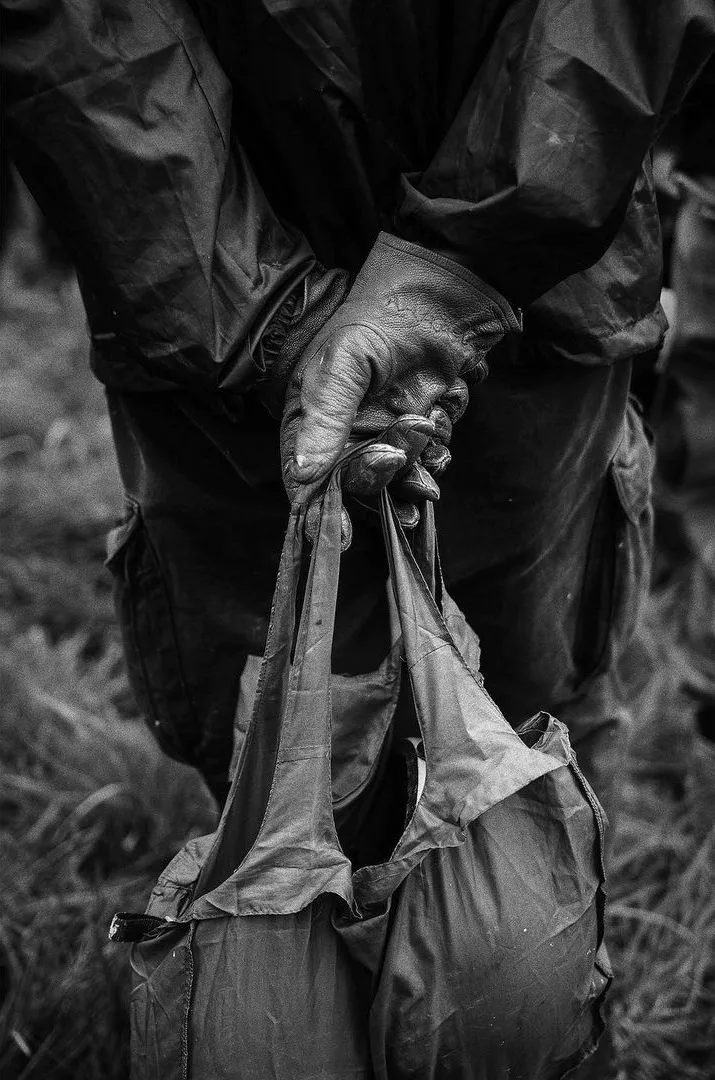

Despite all that, following a meticulous organizing plan in an area that had been checked and re-checked over the course of a week, 300 people succeeded on Friday morning in setting up tents, medic areas, generators, port-a-potties, etc. — all under the nose of the police — resulting in an encampment that welcomed some 5000 people later that day. But after such an operation, there was little time left for discussion and preparation of the next day’s demonstration.
“Be water,” even on a tractor
In the early afternoon, a public gathering was announced at Lusignan where the tractor convoy was to meet up with international delegations for a press conference. As they approached Lusignan, it was clear that the Vienne and Deux Sèvres prefects were going to do everything in their power to prevent the tractors from reaching the encampment. To put fortune on their side, the farmers decided to turn away from Lusignan and head directly to the N10 to shorten their route. This unforeseen change of plan forced the state police to deploy on the N10 and to block the offramps of the highway in a hurry. In reaction, a march of several hundred people set off from the encampment to lend a hand to the farmers. Confronted by an imposing apparatus set up at both highway offramps as well as on the bridges above the regional train tracks, which made accessing the encampment from the highway all but impossible, the march decided to invade the tracks. This action forced a section of the police to abandon its position and intervene, thereby freeing up a bridge in the meantime. By the end of the afternoon, both Highway 10 and the LGV train line connecting Paris-Bordeaux were blocked. Despite negotiation attempts by the Conféderation Paysanne spokespeople, the authorities refused to let the tractors pass.
In face of the authorities’ inflexibility, the farmers improvised. A few kilometers from the final offramp allowing access to the encampment, the tractors slipped away from the police escort and made an epic escape: they ditched the four-lane highway in order to race the police down the rural roads and pathways, before infiltrating the forbidden zone and passing over the liberated bridge at the last minute. The tractors rolled into the camp to glowing fanfare just as the day came to a close.
The encampment set up and the convoy’s passage reveals several elements of importance: firstly, that with both meticulous planning in a broad composition as well as rapid improvisation, it is sometimes possible to thwart an asymmetrically powerful apparatus. Secondly, we are stronger when we are in motion. This intuition was reinforced by the events of the next day, as the conflict and the confrontation became bogged down in a war of attrition, which was clearly detrimental for us.
Repetition is not reason
If we now turn our attention to Saturday, we can see that the tactical repetition between the first and second battles of Sainte-Soline was a major error. In hindsight, it’s hard even to retrace the thread that led us there. Despite the common sense idea that advises against attempting the same thing twice, it’s as if a kind of funneling happened, in which the progressive shrinking of possibilities pushed us to reproduce the same movement.
In many ways, the tactical arrangement of the marches has not managed to evolve since that rally in October. In an open countryside like this, where the expanses stretch as far as the eye can see, there are only so many paths one can take. Hence the idea, that day, to proceed once again to the edge of the reservoir, try to encircle it, and if the situation permitted, to reach it. However, we weren’t ready to enter at all costs.
Given the topographical constraints — the overhanging reservoir accessed only by a vast open area — the difficulty lay in successfully creating a surprise. But since we had announced publicly that we were going to Sainte-Soline and/or Mauzé sur le Mignon, we didn’t think we could keep any secrets about the day’s objectives. With the camp lying outside the red zone, we were worried about finding ourselves blocked and confronting a police apparatus at the edge of the red zone, which would provoke a clash miles away from the reservoir. The Prefect could legally arrest us in front of the red zone, but the state police had also drawn a few lessons from October. That morning, we were relieved to discover that the bridges around Vanzay were clear. By castling in and around the reservoir construction site, the cops had committed themselves to a strong defensive position. Although this “castle maneuver” was predictable, we lacked the requisite time and creativity to communicate and overcome this situation. It would be difficult to force the police out of the reservoir. The pipes are part of the construction work, we always say, but the technical difficulties of dismantling them did not make it the kind of goal that tens of thousands of people could participate in.
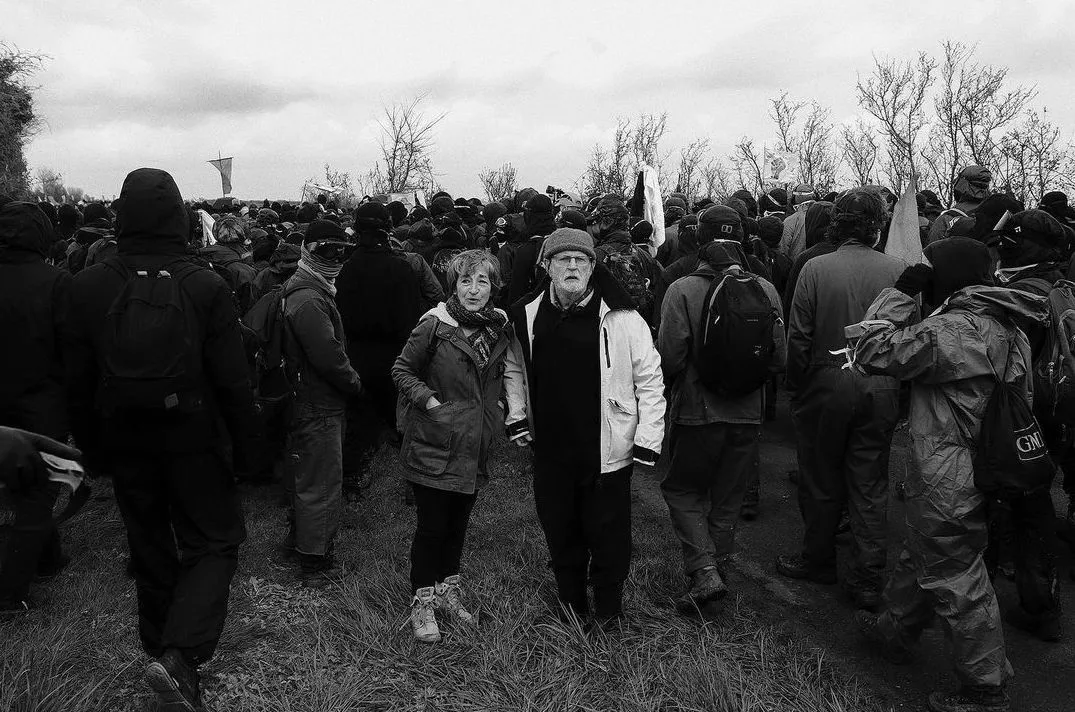
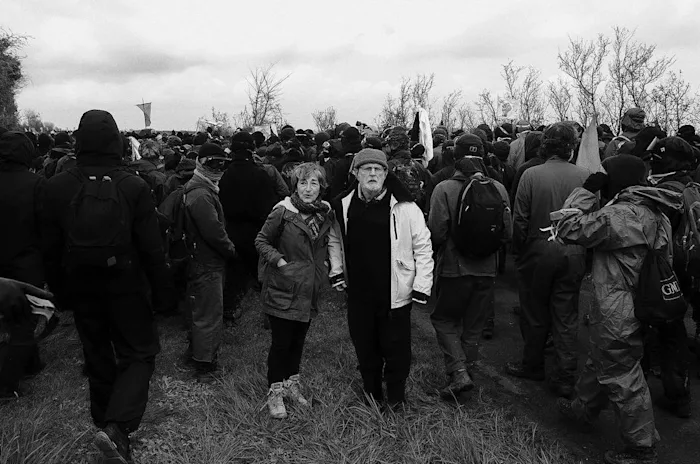
Nevertheless, we believed that if we could reach the reservoir our numbers would allow us to surround it, leaving the perimeter open to various approaches that could eventually permit us to tear down the fences and to halt the construction — if only temporarily.
3. Change of scale
March 25th signaled a quantitative leap in participation in the movement against water grabbing. How can we coordinate and continue to move together while taking this change of scale into account? The considerable enlargement of the marches entails an evolution of our modes of information transmission and collective decision making, before and during the demonstration — an evolution that we did not anticipate well.
Our goal has been to take singular struggles and escalate them, to make them resonate, in the hopes that the enthusiasm they generate will overflow the initial impulse, that the situation will overflow us, thereby rendering our ability to emerge and coordinate indecipherable and unpredictable for our enemies. We cannot master such overflow, nor do we seek to, since it extends far beyond the strength of our own forces. When a struggle reaches this point, it awakens in tens of thousands of people the hope of winning against something bigger than ourselves. The first battle of Sainte-Soline had exceeded our expectations, and we welcomed this overflow, and hoped to see it emerge again; yet we did not sufficiently take into account what such a change of scale would mean.
This change of scale in participation from October frightened us, at the same time as it delighted us. We attempted to recreate the conditions that allowed us to reach the reservoir during the first battle, with the same scale in mind. But leading three marches of 2500 people isn’t the same thing as coordinating three marches of 10000 people. The forces actively organizing the operation, as well as the means of communication implemented, needed to be adapted to the change of scale. Without a doubt, we failed to better anticipate what a pure fortress-like police line would produce. By the time we realized this, it would have been difficult to completely divert our collective energy away from the symbolic target of the construction site and its guards, but perhaps we could have imagined ways to avoid confronting it so directly.
Our usual strategy, which consists of eluding and foiling the police line, was undermined by the enemy’s plan that day, and by the inertia and difficulty of communication from within a crowd that was already in motion. The first march of the pink bustard arrived on the scene easily, and formed a kind of human chain along the west side of the reservoir. It got rained upon by tear gas canisters, but still held fast for an hour and a half, as people of all ages formed a single body together, advanced in a line, burying the tear gas as they went. When this line finally came into contact with the police line, attempting to push them back with nothing other than inflatable animals, offensive grenades began to rain down upon them too. At the same time, a set of smaller, more mobile groups advanced in order to seize the opportunity to break through the police line at the point where the main crowd had arrived. They imposed relentless pressure on the police line. The processions left at the back, bigger and less mobile, were besieged by grenades and unable to coordinate.
Without a pre-established backup plan, nor any capacity for improvisation in such a large demonstration, things quickly went from bad to worse. We would have needed a real time-out to imagine something else, but we no longer technically had this possibility. When the seriousness of the number of wounded was shared from one procession to another, the inadequacy of our collective means became glaring. Above all, the means to evacuate the wounded, but also to communicate between the marches. Even if it wasn’t obvious to everyone, we pushed for a collective withdrawal from the area.
At this stage, the other actions carried out in parallel by the farmers and other processions — building a greenhouse, planting hedges, dismantling the networks that fed the reservoir — seemed quite paltry and relatively invisible.
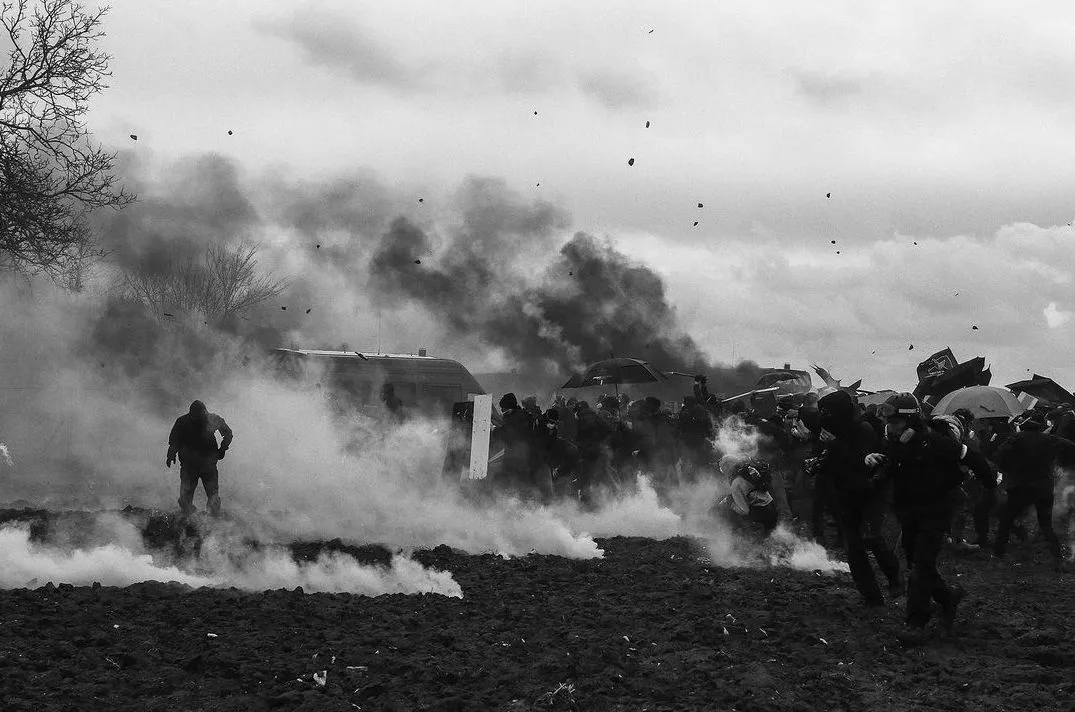
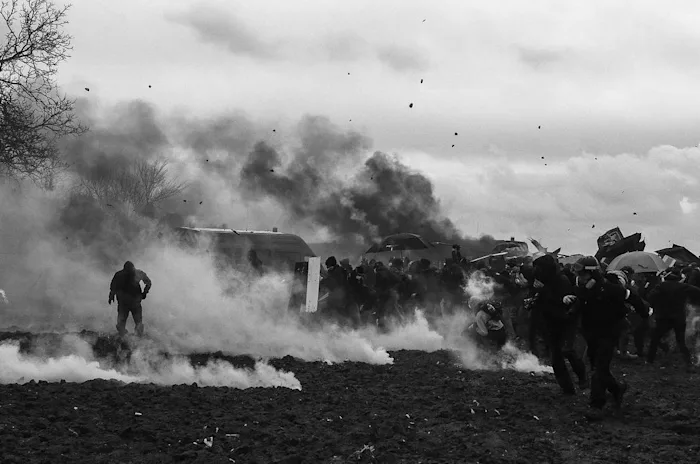
Due to these same requirements of scale, an immense amount of work was done by the rear base in terms of organization, structure, and support before, during, and after the demonstration. Included in the coordination but also structured as an entity in its own right, the base was able to adapt to the change in scale. And we had a long way to go. To give an example, in October, our organization had not thought of providing psychological support or fighting against sexist violence for such an event. Likewise, in a few months the Infoline switchboard evolved from a single telephone managed part-time by one person to a 24-hour team from Thursday to Sunday, set up to help participants join the weekend. After October we felt the need to take this into account, and a beautiful process of organization was set in motion that then proved a valuable contribution to the weekend and its aftermath. The rear base’s work, like the legal work, is still in process. On the side of action, we need to recognize where the necessities that accompany a change of scale have not been sufficiently anticipated. More generally, a real study of the effects of scale is required, specifically in terms of advance organization and the spread of information.
4. The maintenance of order
Police violence and its legitimization by the state are nothing new. It has always plagued the abandoned and invisibilized populations. It has long been (and remains) a rather distant abstraction for most of the citizens of this country. It took the emergence of movements of a spontaneous and overflowing struggle like that of the yellow vests, the youth black blocs against the 2016 Labor Law, and the ZAD for the weapons that maim the people living in the banlieues to begin to threaten almost anything that stirs. Sainte-Soline is one of the latest examples of this. The risk of losing a limb or dying in our efforts to construct another world is increasingly shared. The young generations will have to live and fight with this risk.
While we expected gas, grenades, tanks, and the whole military arsenal regularly deployed, we did not expect this déluge. Given the different factual “errors” made by police and the Interior Ministry’s comm’s service, it is difficult to believe the numbers given, but we can try to make this comparison: for the 5000 grenades fired in two hours, we must compare the 11000 grenades fired in one week on the ZAD in Notre-Dame-des-Landes in 2018. Despite the memory of Rémi Fraisse’s death, we weren’t ready to face such a desire to kill. A milestone has been passed.
In the midst of protest against the retirement reform, in a political moment where environmentalism is laden with conflictuality, the government attempted to shock the world by raising the possibility of maiming and killing without comment or question. It’s one more occasion to witness, without any decorum, the State’s normal expression of its claim to legitimate violence. By claiming that the crowd is “illegitimate,” this is where Macron has situated the debate.
The apparatus deployed by the police forces was designed to break our forces beyond that day. And this is what the police feedback group is still congratulating itself about: to see us return to the camp “demoralized.” Their obstruction of access to medical assistance for people in life-threatening emergencies reveals this strategy of tension. Despite the efforts of the medic teams on site, we realize that we will have to count more than ever on ourselves to defend our friends and provide them with good and proper care.
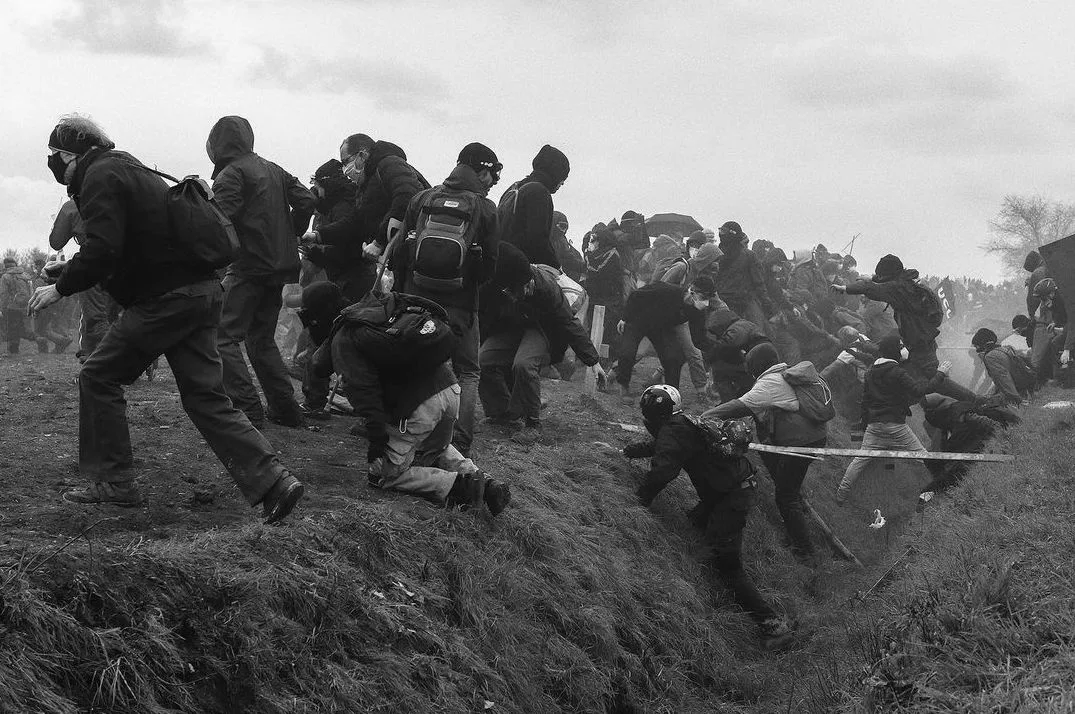
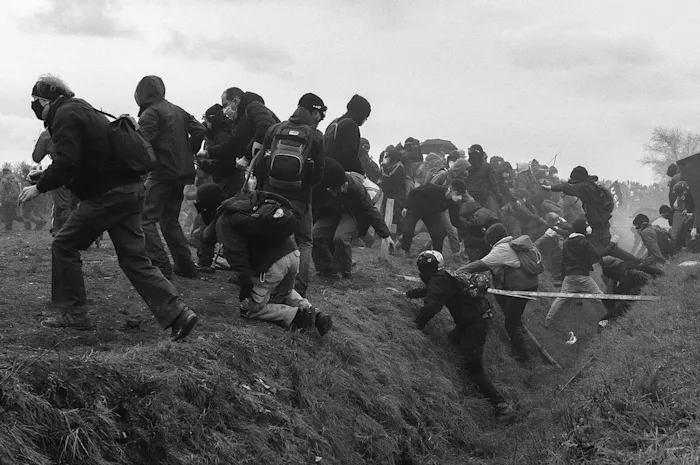
The State has militarized the question of water. On that day, it made that hole in the ground the symbol of its authority, a metaphor for its power. We went up against the construction of the mega-reservoirs in order to stop them from investing so much money in the works and to expose their vulnerability. Our forces were unequal. Despite this fact, the determination to break through the police lines was impressive. The dispersal of our collective body did not discourage certain people’s determination to break through the line. This desire drove some of the processions, even if it was impossible for the whole. The success of the previous mobilizations lay in the fact that all of the demonstrators could take an active part in “passing through.” But passing through to go where? Most of the thousands of people there on March 25 couldn’t participate in this gesture. The crowd, held at a distance by the rain of grenades, found themselves spectators of this moment without being able to act on it. The marches attacked the fences of the construction site and part of the police line that was protecting the fences was momentarily put in trouble. But it is clear to us that such a direct attack was far too costly. And words are never enough or always clumsy when it comes to writing or saying it.
Afterwards, people everywhere took time to discuss and listen to each other. Many recalled the evasive tactics that made October so successful. Many of us who found ourselves in the streets the following weeks were struck by a certain sadness and a new sense of foreboding. The past weeks have rekindled in us an anger and a rage that are spreading widely, dispelling any remaining resignation.
Temporary Conclusions
Last October, when we packed up camp the day after what we now call “the first battle of Sainte-Soline,” we asked ourselves: how can we go further? How can we attain the definitive abandonment to all of these reservoir projects? These are the questions that motivated the coordination during the four months of preparation for March 25. Even today, it’s unclear if we have drawn the full measure of the impact that weekend in October had. Did it open up a form of hope concerning the question of the reservoirs or ecological struggle more broadly? On the vital problem of water? We saw a symbol emerging, with all of the ambivalence between hope and expectation that these can harbor: mega-reservoirs as a symbol of the climatic aberration of agro-industry and of the total allegiance that the ruling authorities have pledged to it.
In the short memory of the struggles in which we have participated, we had never experienced what happened on March 25. We have witnessed attacks on fortified sites in Sivens, but also in the Val de Susa, on the other side of the Alps, during the NO-TAV struggle. The threshold of intensity that was crossed in the repressive violence of Sainte-Soline demands a rethinking of our tactical impasses, and an effort to overcome them. The struggle against the mega-reservoirs has only just begun. They cannot fortify each and every one of these sites. And if local committees spread everywhere, it is not one project that could be attacked, but dozens. After Sainte-Soline, the struggle will need to reinvent its forms of intervention, regain confidence in its collective capacity to produce impactful gestures, while maintaining as broad a composition as possible.
We are tending to our wounds and thinking of the wounded. We need to reassemble the different narratives of what the day meant for everyone. We will continue to support the wounded, to struggle against the hoarding of water, and to take the streets against the retirement reform, because there is a continuity among these different fronts. These issues are linked together, underwritten by same stupid and hated policies pushed by Macron, which care nothing for what they destroy as long as the markets are secure. The mobilization against the reform is massive, as is the awareness of the ecological stakes. The absence of dissociation and the solidarity among a broad political spectrum so far has been remarkable. The distrust of the executive branch is only matched by the anger brought out by the images of daily police violence on the news and networks.
Macron’s attempt to get back on track at Serre-Ponçon lake was interesting because it showed that those who marched at Sainte-Soline were able to place the question of water on the agenda. With its “water plan,” the power system has taken advantage of the shock to unroll a false discourse about water, the mega-reservoirs, and to reverse the ban on pesticide. This communication maneuver by the President was quickly swept aside by the startling reality of drinking poisoned water. There hasn’t been a day since without an article published about water, its scarcity or its contamination. The stakes are real, the problem is reaching a growing number of people, whose feelings tend towards revolt. The struggle around water is open; it is vital to continue fighting, let’s prepare for what comes.
—Les Soulèvements participants at the March 25th coordination.
First published in Lundi Matin #379, April 17th 2023.
Translated by Scott Branson.
Images: Marion Vacca